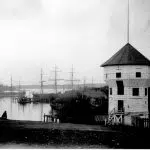
Ship that sank 52 years ago off B.C.’s coast now polluting marine park
VANCOUVER — A cargo ship that sank off the west coast of Vancouver Island more than 50 years ago is now polluting the waters of a popular marine park.
The Canadian Coast Guard says a fuel-like sheen was investigated in September and was thought to be bilge discharge from a ship, but the problem continued and a deeper look uncovered the historic wreckage.
The MV Schiedyk left Gold River, B.C., with a load of wood pulp and barley on its way to Oregon on Jan. 3, 1968, and hours later hit a ledge off Bligh Island in Nootka Sound.
The area where the 150-metre ship went down is now a provincial marine park.


